Digital Payments
Digital technology is transforming the way we respond to emergencies. Innovations range from how we identifying people eligible for assistance, to data collection for assessments and monitoring, to communication with crisis-affected communities. Digital payment systems, including mobile devices, electronic vouchers, and cards – when used appropriately – can deliver timelier, more secure, more cost effective, and inclusive assistance. But as the volume of data we collect, store and share about people grows, we must ensure that our data protection systems keep pace and that we understand and mitigate for the risks inherent in new technologies.
Featured Content
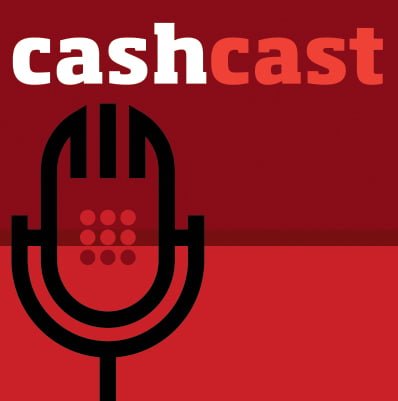
Podcast: Is informed consent possible in humanitarian CVA?
Podcast
Episode 2 of the CashCast tackles data responsibility with Amos Doornbos, Linda Raftree, James Eaton Lee and Ric Tighe

Consent and Ownership in the Shift to Digital Cash and Voucher Assistance
Blog Post
Part of committing to cash and voucher assistance (CVA) is committing to going digital and collecting data. While they are two different things, they are deeply intertwined. And while an organisation can ‘go digital’ without cash programmes, it’s nearly impossible to commit to cash programmes in the long term without going digital. Yes, it is true we’ve done cash and voucher programmes...
Latest
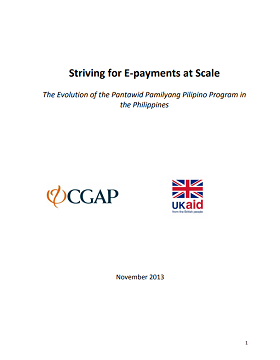
Striving for E-Payments at Scale in the Philippines
Report
As the Philippines experienced economic growth in the early 2000s, it still saw a rise in poverty. The Pantawid Pamilyang Pilipino Program (4Ps) is a conditional cash transfer program that aims to provide short-term poverty alleviation for poor households. The program emerged out of the country’s...
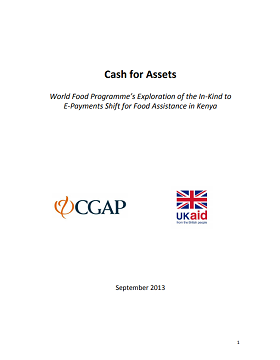
Shifting Food Assistance in Kenya to E-Payments
Report
The shift away from in-kind aid as the preferred mechanism for humanitarian assistance has contributed to the rise of cash transfers in Kenya. In 2008, the World Food Programme (WFP) for the first time shifted strategically from a food aid to a food assistance strategy, recognizing new and diverse ways in...

E-Payments in Uganda with Limited Infrastructure
Report
The 2005 Uganda Chronic Poverty Report argued that households in chronic poverty show a range of deficits that include deficient consumption and malnutrition, limited access to health and education, and limited voice and influence. For many of these households social exclusion reinforces their...

An Innovative way of Humanitarian Assistance using Mobile Money Transfer in Bangladesh
Presentation
A video detailing Oxfam’s use of mobile money transfer in Bangladesh.

Protecting Beneficiary Privacy: Principles and Operational Standards for the Secure Use of Personal Data in Cash and e-transfer Programmes
Guidelines and Tools
The use of electronic transfers (e-transfers) in cash transfer programming has grown in the humanitarian sector and is increasingly recognised as an effective and efficient intervention in certain emergency contexts. Following recommendations made by a CALP research in 2011 on e-transfers ‘New...

E-transfers in Emergencies: Implementation support guidelines
Guidelines and Tools
Electronic transfers, or e-transfers, are a form of value transfer that relies on digital payment systems. The great many benefits they can realise for aid recipients and aid agencies alike in terms of increased security, convenience, privacy, speed, reduced operational/transaction costs and logistics,...
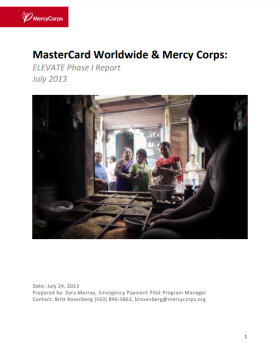
MasterCard Worldwide and Mercy Corps: ELEVATE phase I report
Report
The Nepal pilot focused on testing several key stages in the deployment of mobile vouchers, including the following: Identify a technology partner, Customize a mobile voucher platform, and Use the platform to distribute goods to people in need. Two different types of mobile vouchers (SMS and smartphone...

ICT/mobile Phone Technology: A shift in the right direction
Blog Post
Thirteen African nations came together for the AgriKnowledge Share Fair in Addis Ababa at the end of October 2012 to learn about approaches for quicker and more efficient humanitarian response. Government representatives, researchers, UN agencies and NGOs gathered for a three day symposium on best...

New Technologies in Cash Transfer Programming and Humanitarian Assistance
Report
This study was commissioned by the the CALP Network in 2011, to review the current use of new technology in humanitarian cash and voucher programming and the broader implications for humanitarian practice. The research was undertaken to explore (i) preconditions for the use of technological...

New Technologies in Cash Transfer Programming and Humanitarian Assistance – Executive Summary
Report
This is the executive summary of the CALP Network’s research on new technologies in cash transfer programming and humanitarian assistance. For more, please see the full report.
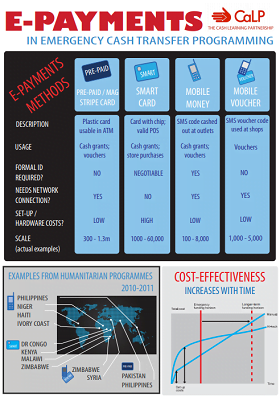
E-payments in Emergency Cash Transfer Programming
Guidelines and Tools
This 2-pager summarises some of the main features, benefits and challenges of 4 different electronic payment methods that can be used to deliver cash transfers in an emergency: pre-paid cards, smart cards, mobile money and mobile vouchers. It is drawn from the CALP Network research on New Technologies in...

Guidelines: How to use Hawala in Somalia
Guidelines and Tools
Money transfer companies, also known as Hawala, are an increasingly popular partner chosen by humanitarian agencies to distribute cash in Somalia. This brief will explain what Hawala are, how they operate, and provide some brief guidelines on how agencies can partner with them to deliver cash transfers in...

MPESA Project Analysis: Exploring the use of cash transfers using cell phones in pastoral areas
Report
Safaricom Limited, a mobile network operator in Kenya, launched a mobile money transfer system called M-PESA in 2007. This system allows users to send or receive money on their Safaricom SIM card. Télécoms sans Frontières and Vétérinaires sans Frontières – Germany decided to work in partnership on...
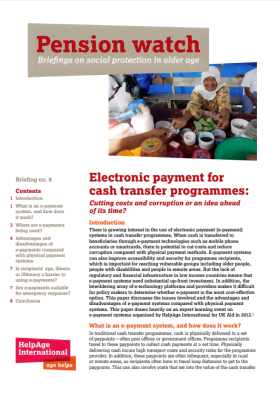
Pension Watch Briefing #8: Electronic payment for cash transfer programmes
Policy paper
There is growing interest in the use of electronic payment (e-payment) systems in cash transfer programmes. When cash is transferred to beneficiaries through e-payment technologies such as mobile phone accounts or smartcards, there is potential to cut costs and reduce corruption compared with physical...

Mobile Technology in Emergencies
Policy paper
Mobile phones are increasingly accessible to those affected by crisis and can play a strategic role in the delivery of rapid, cost-effective, scalable humanitarian assistance. However, the full potential of mobile phones to work as transformative tools in emergency response has not yet been realised. This...
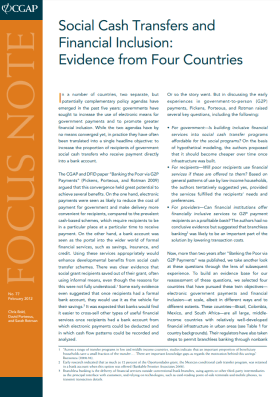
Social Cash Transfers and Financial Inclusion: Evidence from four countries
Report
This focus note from CGAP looks at social cash transfers and how this is being used to improve financial inclusion. To do so they look at examples from Brazil, Colombia, Mexico and South Africa. The focus note compares the various payment approaches, how these interlink with the respective government...
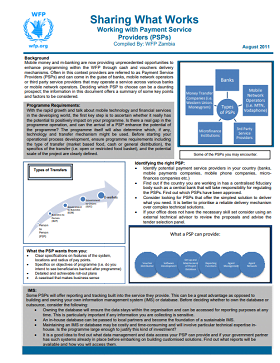
Sharing What Works – Working with payment service providers (PSPs)
Report
A handy tool on choosing payment service providers for delivering cash transfers developed by WFP Zambia. Mobile money and m-banking are now providing unprecedented opportunities to enhance programming within the WFP through cash and vouchers delivery mechanisms. Often in this context providers are...

Electronic Payment Systems 201
Guidelines and Tools
Disruptive innovation in the payments sector—and indeed the retail financial services industry—does not occur frequently. This is partly due to the dominant position of the incumbent players (primarily banks and payment networks), and partly due to the nature of the sector itself: as they relate to...
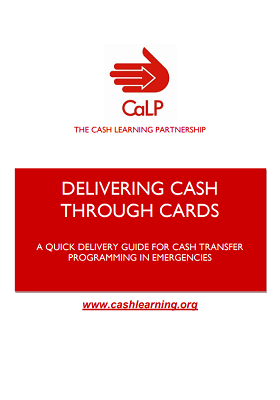
Delivering Cash through Cards: A quick delivery guide for cash transfer programming in emergencies
Guidelines and Tools
A Quick Delivery Guide to delivering money through cards (magnetic stripe or smart cards). Prepared as a practical tool, this guide provides a brief synthesis of the necessary preconditions and advantages and disadvantages of using cheques. It also provides practical implementation tips.
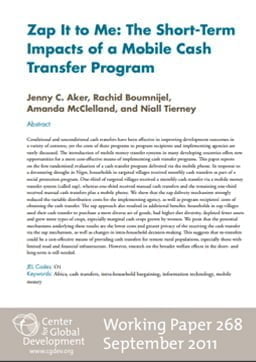
Zap It to Me: The Short-Term Impacts of a Mobile Cash Transfer Program
Report
Conditional and unconditional cash transfers have been effective in improving development outcomes in a variety of contexts, yet the costs of these programs to program recipients and implementing agencies are rarely discussed. The introduction of mobile money transfer systems in many developing...


